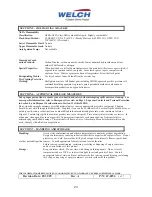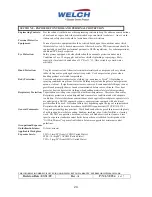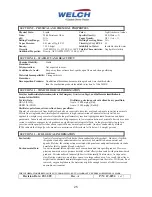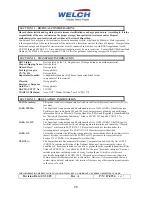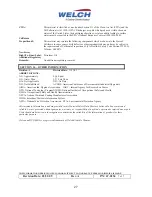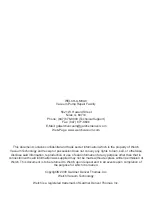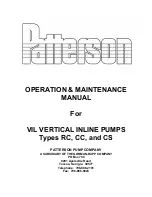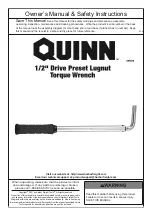
25
THE INFORMATION HEREIN IS GIVEN IN GOOD FAITH, BUT NO WARRANTY, EXPRESS OR IMPLIES, IS MADE.
Revision Date: 03/31/09
Rev. A
P/N: 67-0254
5 of 7
SECTION 9 – PHYSICAL AND CHEMICAL PROPERTIES
Physical State:
Liquid
Color:
Light Amber to Amber
Odor:
Mild Petroleum Odor
Specific Gravity:
0.88(Water = 1)
pH:
N/A
Vapor Density:
GT 1 (Air = 1)
Boiling Point/Range:
N/A
Melting/Freezing Point:
N/A
Vapor Pressure:
0.01mm of Hg (20°C)
Viscosity (cSt @ 40°C):
65
Density:
7.30 Lbs/gal.
Solubility
in
Water:
Insoluble in cold water
Viscosity
(ASTM D2161) = 339 SUS @ 100°F
Volatile Characteristics:
Negligible volatility
Additional Properties:
Gravity, API (ASTM D287) = 30.0 @ 60°F
SECTION 10 – STABILITY AND REACTIVITY
Chemical Stability:
Stable
Hazardous
Polymerization:
Not expected to occur.
Conditions to Avoid:
Keep away from extreme heat, sparks, open flame and strong oxidizing
conditions.
Materials Incompatibility:
Strong oxidizers
Hazardous
Decomposition Products:
No additional hazardous decomposition products were identified other
than the combustion products identified in section 5 of this MSDS.
SECTION 11 – TOXICOLOGICAL INFORMATION
For other health-related information, refer to the Emergency Overview on Page 1, and the Hazards identification in
Section 3 of this MSDS.
Toxicity Data:
Distillates, petroleum, solvent-refined heavy paraffinic:
ORAL (LD50):
Acute: >5000 mg/kg [Rat].
DERMAL (LD50):
Acute: >2000 mg/kg [Rabbit].
Distillates, petroleum, solvent-refined heavy paraffinic:
Mineral oil mists derived from highly refined oils are reported to have low acute and sub-acute toxicities in animals.
Effects from single and short-term repeated exposures to high concentrations of mineral oil mists well above
applicable workplace exposure levels include lung inflammatory reaction, lipoid granuloma formation and lipoid
pneumonia. In acute and sub-acute studies involving exposures to lower concentrations of mineral oil mists at or near
current work place exposure levels produced no significant toxicological effects. In long term studies (up to two
years) no carcinogenic effects have been reported in any animal species tested. Analyses conducted by method
IP346 indicate that the polycyclic aromatic concentration of this mineral oil is below 3.0 weight percent.
SECTION 12 – ECOLOGICAL INFORMATION
Eco-toxicity:
Analysis for ecological effects has not been conducted on this product. However, if spilled,
this product and any contaminated soil or water may be harmful to human, animal, and
aquatic life.Also, the coating action associated with petroleum and petroleum products can be
harmful or fatal to aquatic life and waterfowl.
Environmental Fate:
An environmental fate analysis has not been conducted on this specific product. However,
plants and animals may experience harmful or fatal effects when coated with petroleum-based
products. Petroleum-based (mineral) lube oils will normally float on water. In stagnant or
slow-flowing waterways, an oil layer can cover a large surface area. As a result, this oil layer
might limit or eliminate natural atmospheric oxygen transport into the water. With time, if not
removed, oxygen depletion in the waterway might be enough to cause a fish kill or create an
anaerobic
environment.













